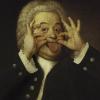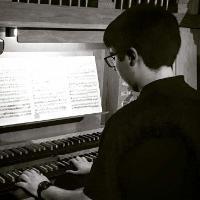All Activity
- Past hour
-
After coming home I took my guitar and wanted to experiment. There is a bit of microtonal stuff in there based on tuning. I have written a piece for orchestra and guitar before, but for some reason I feel like I am overwhelmed with possibilities at the moment. My plan is to expand this idea for orchestra. This is basically a transcript of my improvisation. It will be orchestra with a guitarist. I want to brainstorm this stuff. Form will not be identical. Feedback on notation technique is appreciated as well. I actually thought about removing all the time signatures (since the caesura signifying a 1/16th note break is a compromise in itself), but it's there for now. Audio file isn't perfect, please check the score simultaneously (had problems with the arpeggios where there is a simultaneous E and E-10c). (Oh yeah, this is on solo guitar, it doesn't say it on the score apparently) For some of my own immediate thoughts: I am in-between starting the orchestral version with the guitar on its own or starting with an intro of some kind. I like the abruptness of the start of the guitar theme. It's like stubbing your toe and being angry at the table corner for bestowing such pain upon you. The guitar impro version is also quite dense, so maybe there's space between the ideas. Additionally there is a lot of fragmentation, which can work well in a Rite of Spring style, where everyone sort of does their own fragment. Maybe this could grow over time (I also like the returning to theme). In the C part the recording does not convey what it sounds like on the guitar (issues with my own technical limitations aka lack of will to fight with musescore) and there is something I want to do there. One of the larger problems will be the microtonality. Of course guitar is quite a different instrument to many others and the microtonality here is relatively tame (except for the bends) and some instruments can certainly be prepared to match the vibe of the guitar (microtonally tuned harp?), but I feel like it will still pose many issues. Although I must admit, sometimes older string quartets etc. are not perfectly in tune - and I love that vibe. And if you find the piece humorous or straight up dislike it, don't be afraid to say it! I don't want to be stuck in an echo chamber and I have thick skin. Honest feedback is my favourite. Keep in mind still that this is the start of an idea. Apologies if there are some etiquette mistakes, new here. Love from Finland -Pyry 30 degrees.pdf
-
PaavolaPyry joined the community
- Today
-
Obviously everyone hates this! LOL! I wrote it at great speed, and the idea was to make a piece with a very bizarre and fluid structure, to match the odd instrumentation. I wanted to try writing for a weird collection of contrabass instruments, as I thought this would be a good challenge. The contrabass ophicleide is one of the rarest instruments in the world, with only five in existence, three of which are unplayable: so I can rest safe in the knowledge this will never be performed! 🤐
- 1 reply
-
- 1
-

-
John Williams style cue
Alex Weidmann replied to Alex Weidmann's topic in Orchestral and Large Ensemble
Thanks so much for listening! That's all all really helpful. The challenge was apparently inspired by a short cue from Harry Potter ("Buckbeak's Flight"); although I didn't actually discover that until after I'd finished writing on day 5! For the piano sketch, we were told to use four piano tracks, one for melody, one for harmony, one for counterpoint, and the last one for extra flourishes. It's actually quite a good idea, because it makes the orchestration process much quicker and easier. We were told to write about 30 seconds of music; though I went beyond that (and some people ended up writing about 2-3 minutes!) I wanted to use harp and celesta for extra colour, as these are frequently employed by Williams. He also tends to have triad fanfares in three trumpets quite often: so that's why I used one here. Probably should've added some woodwind runs as well; but I felt that would make it too busy. The challenge gave me some new composition techniques: so it was definitely a helpful thing to take part in. I may decided to expand this into a longer work of 5-10 minutes at some point. Anyway, thanks again for the analysis, and the links. Alex. -
PeterthePapercomPoser started following 12 Variationen Über Das Lied "Heidenröslein"
-
I AM taking the repeats out of this piece; it is certainly not as good as my new variations with the Deutsch name (Hey, German poem by Goethe, of all Germans); it will not take me long!
-
JP S. started following John Williams style cue
-
Hey man! Great work at coming this far. I can tell that this style of orchestration was stretching you, but I hope it opened your horizons and you’re growing a lot:) Here are a couple of my thoughts: Distortion: I also noticed the distortion over time. It was slight and in the background, but perceptible. I agree with both the above analyses that it’s part Musescore (which could be fixed with a DAW), and part a thicccc orchestration lol:) Composition: This is already a great start. I don’t know if I would call it a “cue” (that seems to mean introduction to me), but it seems like a mid-scene Star Wars music. What I think would help you most would be developing your melody with a more cohesive theme (maybe using period or sentence forms), then using it to create a simpler piano sketch. Having everything sketched out on one (or two for complex pieces) pianos/organs/accordions helps to have a clear vision of how much harmony is going on at once. Then you can orchestrate and double all you want to get the timbre you’re looking for. These are some of the most helpful videos I’ve found for this topic, from my favorite YouTube composer Ryan Leach: This one covers using just a basic 4 or 5 part writing sketch, then adding octave doublings to give it an epic feel. I really recommend only using 4-5 parts/pitches at a time for emotional purity. This will also help cut down on the mud/distortion: Next is an example of another young composer who was coached into writing a cinematic piece from a sketch. Then finally, “How to Orchestrate…” is the pro composer’s version, starting from a more complex 2-piano sketch. I hope that in giving high quality feedback, I might be able to receive high quality feedback when I post something:)
-
Clicked on this and listened to it, but I just got defeated in trying to write a white-heat piano piece in one sitting, and my brain hurts, but having even read Beethoven piano sonatas ON THE TOILET! Beethoven himself would not turn up his nose at this, and it DOES sound a bit like him, though not derivative; I would say in the style of, it's like one of his easy-going first movements of a piano sonata. I WILL listen to the whole thing.
-
Aurora (Ancient Greece inspiration)
Churchcantor replied to Luis Hernández's topic in Piano Music, Solo Keyboard
This is a really good piece, and I have really been enjoying your music! Very exotic, and you are well-trained and have done your homework.😃 -
Henry Ng Tsz Kiu started following 12 Variationen Über Das Lied "Heidenröslein"
-
12 Variationen Über Das Lied "Heidenröslein"
Churchcantor replied to Churchcantor's topic in Piano Music, Solo Keyboard
Hey, some of you pianists here learn this right fast, ya hear? 🤣 Ich koennte auf den Boden gefallen und sterbend lachende!-W.A. Mozart. My German is improving...but still rudimentary. -
BTW, I never mess with dynamics, slurs, bowings, etc. in Noteflight; it takes a long time to enter there anyway, and dynamics sound exaggerated. My scores if written in manuscript have these things, but if writing direcly into Noteflight as this one, and the one I just posted are, I also don't bother. Anyone playing my Noteflight music may edit the scores themselves.
-
Churchcantor started following 12 Variationen Über Das Lied "Heidenröslein"
-
12 Variationen Über Das Lied "Heidenröslein" Free Sheet Music by Robert C. Fox for Piano/Keyboard | Noteflight Began this piece at about 11:30 last night and trying to finish in twelve hours, writing directly into Noteflight, and it is a virtuoso showpiece. Took on a life of its own, and I can't even play piano! I am giving myself a sort of Diary in the comments!
-
Marius_ started following My First Ensemble Piece Ever Recorded - Any Thoughts?
-
My First Ensemble Piece Ever Recorded - Any Thoughts?
Marius_ replied to Mooravioli's topic in Chamber Music
Hey Mooravioli, I like your piece. The harmony is weird and complex. I think for this kind of music the danger is making the harmony too unconventional, which makes the piece hard to listen to. A lot of people that experiment, do it too much. You don't: you keep the listener hooked and curious, and know how to tell a story through chords. Another thing that helps is your use of melodic motives. Really nice! I especially like the resolution and ending from bar 195 onwards. Consider using a tenor saxophone instead of alto, it better suits the melodies you've written. Low notes on sax are often harsh and unpredictable, writing a little higher in the instruments range can give a nicer sound/more freedom to the player to choose the right sound. You can also definitely explore the vibraphone's abilities more. Remember that professionals can play four notes at once! Listen to some bebop vibe players for reference. Also, five sharps (or four for tenor)? why would you do that to anyone? If you raise everything a semitone (Eb major, concert pitch), your players will thank you. As for the genre - this isn't jazz. I would probably call it contemporary classical. If you want to write jazz, listen to the music. If you'd like to write in any style, you need to be familiar with that music. Of course that shouldn't discourage you from writing this music at all! It sounds cool, and that is what matters. I just wanted to say, if you call this jazz and show it to a jazz musician, they will look at you like "🙂 that is really ~interesting~ jazz 🙂". For improvisation, your best bet is to write chord symbols and let one player completely free, like in traditional jazz songs, because that is what players are used to. Saying 'feel free to improvise' and 'improvise less' is very vague, and may not give the effect you want. What you could say is 'feel free to embellish' or something, if that's what you had in mind. In general: if you don't want someone to play the written notes, don't write the notes... -
Thanks!
-
PeterthePapercomPoser started following RIP Ozzy and Shattered, my newest song.
-
A Cradle Song - Prologue (SATB + Piano)
seo_composer replied to seo_composer's topic in Choral, Vocal
Hello @Henry Ng Tsz Kiu! Thank you so much for your lovely reply! I am really happy you found it soothing! And your suggestion is something I've been debating on for quite some time on the piece but have been unsure about. So, I take this as a good sign to extend it a little more! Seun- 2 replies
-
- choir
- contemporary music
-
(and 2 more)
Tagged with:
-
hello, it's been a while because i switched browsers, but here's a new song! also, can someone tell me what genre this is? i can't tell.
-
I started getting serious about music beginning with heavy metal music over 20 years ago, which Black Sabbath pioneered. Without Ozzy Osbourne, I'd not be a composer today. RIP Prince of Darkness
-
- 1
-

- Yesterday
-

Advice on writing slurs for strings in orchestral music
danishali903 replied to JordiHortal's topic in Advice and Techniques
String player here as well. @HoYin Cheung has given great suggestions/advice. Side note: I'm currently marking bowings for an orchestra to perform Brahms Symphony 4, and Brahms loved his long slurs! Most of them are impractical and I think he didn't really think about how that would translate to the musician playing...but they do give an insight to how he wanted the players to phrase the music. I rarely mark bowings in my own music as I think it depends on the player/section/orchestra and how their style/approach to music. -

Advice on writing slurs for strings in orchestral music
HoYin Cheung replied to JordiHortal's topic in Advice and Techniques
For the crescendo and ff part, for instance, m.24-28, string players have the tendency to use more bows. That will mean the slur across measure 27 and 28 will be seperated in to 2 strokes. Otherwise, you made good notations. And the principal section player will make the decision for you and confidently use their own sets/rules of strokes as long as the whole section are using the same.😆No worries. -

Advice on writing slurs for strings in orchestral music
HoYin Cheung replied to JordiHortal's topic in Advice and Techniques
I am a violinist and a former orchestra player, so my advise should be realistic. I think most of the slurs you marked on this score is appropriate and practical, given most of the lines are in pianissimo or pianississimo. One useful thing to know is that, 1) if the part you are writing is not the main melody that do not need to be that is not that pronounced, and; 2) if there happens to be a decrescendo leading to a p or pp, then the string player is able to play the passage as slow as possible on the same stroke and the bow is treated as infinitely long. That may seem ridiculous, but that's the case. You play the "feeling" there. Tl;dr, 4-5 bar is totally possible with above prerequisite. One reason behind this playing style is that, it requires good technique to make the bow change unnoticeable. Due to the structure of bow, there is more tension at the bottom than at the bow tip. That will mean a natural decrescendo playing down bow (from bottom to tip) assuming a constant pressure applied. The reverse happens too, where a natural crescendo will occur playing upbow. So if there are any bow changes, the shift from cresc. to descrec. might be audible. While experienced players may control the pressure to mitigate the effect, they avoid changing bow unless the same phase really require 2 bows to project with expressiveness. Therefore, most of the cases, we keep it done in one single stroke for the above situations. -
Hello! I’m not sure if this is the right place to ask, but I could really use some advice. I’m currently writing an orchestral piece, and there’s a section where the strings play almost entirely on their own. At first, I used a lot of long slurs, but after reading some books and posts about orchestration, I realize that may not have been the best approach. In your opinion, how should I notate slurs in this passage to make my intentions clear to the performers? The section is very slow, so large slurs seem to be impractical. Thank you very much for your help!
-
Vasilis Michael joined the community
-
I tried to take the given advice into account, and now have a full start-to-finish version of the score! I've put a lot of hours into this and I'm rather proud of how it's turning out, especially considering my overall lack of experience. Transitions between sections of a piece are one of my main weaknesses, and consequently I tend to scrutinize them a bit more, but I feel there's still room for improvement (for example, I can't tell if measures 82-83 sound good or just out of place). That being said, I'm definitely open to suggestions for anything in this piece (especially notes on the ending, another one of my weaknesses). I've improved a lot but I've got a long way to go.
- 2 replies
-
- 1
-

-
- incomplete
- feedback wanted
-
(and 1 more)
Tagged with:
- Last week
-
In classical music, a piece is like an album and movements are like songs in the album. The main difference is that usually people don't listen to movements out of order, since the order is important to the flow of the music, but that's pretty much what a movement is.
-
Not to belittle anyone or be pretentious, but I think it's best to use the correct terminology when discussing these things. A piece can have several movements. Think of the piece (for example, lets say Beethoven's 5th Symphony) as a novel, and a movement as a chapter of that novel (in our example, there are four movements in that symphony). Movements don't have to be similar (melodically or harmonically) and can have varied moods or personalities. Pieces can have anywhere from 2 movements to infinite (a bit impractical and illogical, but theoretically possible). Most of the time, there is a unifying element that tie together the movements, be it musical or external narrative. There are cases where movements are so different from each other that they can be their own pieces, but that is a rare occurrence.
-
buckysmith joined the community
-
My First Ensemble Piece Ever Recorded - Any Thoughts?
therealAJGS replied to Mooravioli's topic in Chamber Music
Great music! I think the bongo sticks and trumpet work perfectly with the theme! -
sorry I haven't been posting any new songs.
-
So, a lot of songs have different movements, and I don't know what they are! most of the time, movements of the same song have a completley different melodys, and are just in the same music genre, and I use FL studio where you just click to add notes and choose an instrument. can someone tell me what a movement is?





